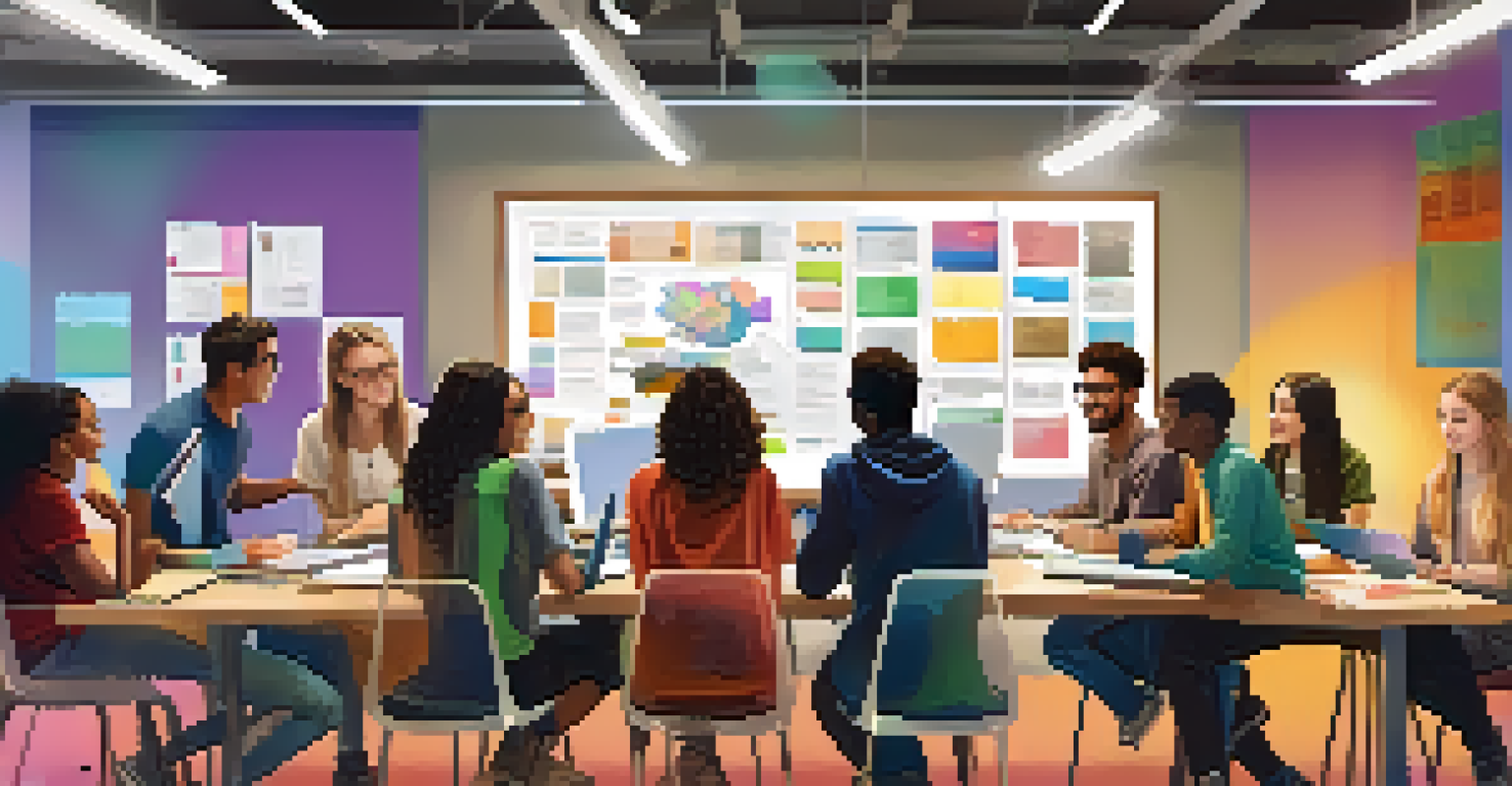Using E-Portfolios to Showcase Learning in Blended Education

Understanding E-Portfolios in Blended Learning
E-portfolios serve as digital collections that showcase a learner's work and achievements. In a blended education setting, where online and face-to-face instruction coexist, e-portfolios become invaluable tools for reflection and assessment. They provide a structured way for students to document their learning journey, making it easier to track progress over time.
E-portfolios are a powerful tool for students to showcase their learning and reflect on their progress.
Think of an e-portfolio as a personal website where students can curate their projects, assignments, and reflections. This not only helps them organize their work but also allows them to demonstrate their skills and competencies to teachers and peers. The visual nature of e-portfolios makes learning engaging, offering a creative outlet for students to express themselves.
Moreover, e-portfolios facilitate personalized learning experiences. In blended education, where students often have varied learning paths, e-portfolios allow them to tailor their content to highlight their strengths and interests. This personalization empowers students, fostering a sense of ownership over their learning.
Benefits of Using E-Portfolios for Students
Students benefit significantly from using e-portfolios as they encourage self-directed learning. As students reflect on their work and set goals for improvement, they become more engaged and motivated in their educational journey. The process of curating content for their portfolio instills a sense of pride and accomplishment.

Additionally, e-portfolios provide a platform for students to receive feedback from instructors and peers. This feedback loop is crucial for growth, allowing learners to refine their skills and deepen their understanding of the subject matter. It also fosters a collaborative learning environment, where students can learn from each other’s experiences.
E-Portfolios Enhance Student Learning
E-portfolios provide a structured way for students to reflect on their work and showcase their achievements, fostering engagement and ownership of their learning.
Furthermore, e-portfolios can enhance students' employability. By showcasing their skills, projects, and achievements, students create a powerful narrative about their capabilities. This is particularly useful in a competitive job market, where employers are increasingly looking for candidates with practical experience and a proactive approach to learning.
E-Portfolios and Teacher Assessment
For educators, e-portfolios provide a comprehensive view of student progress. Instead of relying solely on traditional assessments, teachers can evaluate a student's development over time through their e-portfolio. This holistic approach allows for a deeper understanding of each learner's strengths and areas for improvement.
The future of education lies in personalized learning experiences that empower students to take ownership of their journey.
E-portfolios also facilitate differentiated instruction. By examining the diverse work presented in e-portfolios, teachers can tailor their teaching methods to meet individual student needs. This adaptability is particularly important in blended learning environments, where students may progress at different rates.
Moreover, e-portfolios help teachers identify trends and patterns in student learning. By analyzing the collective work of a class, educators can gain insights into common challenges and successes, allowing them to refine their instructional strategies and improve overall learning outcomes.
Creating an Effective E-Portfolio
Creating an effective e-portfolio involves careful planning and organization. Students should begin by selecting a platform that suits their needs, whether it’s a dedicated e-portfolio tool or a simple website builder. The key is to choose a platform that allows for easy uploading and categorization of their work.
Next, students should curate their content thoughtfully. This means including a variety of work types, such as essays, projects, and reflections, that showcase their learning experiences. They should also be encouraged to write reflections that explain the significance of each piece, providing context for future viewers.
Benefits for Teachers' Assessment
E-portfolios offer educators a comprehensive view of student progress, allowing for personalized instruction and insights into learning trends.
Finally, it's essential to regularly update the e-portfolio. Just like any personal project, an e-portfolio should evolve with the student’s learning journey. By continually adding new work and reflecting on their progress, students can create a dynamic showcase that truly represents their growth.
Engaging Parents with E-Portfolios
E-portfolios can also serve as a bridge between students and their parents. By sharing their e-portfolios, students can involve their families in their educational experiences. This engagement fosters a supportive home environment, where parents can celebrate their child's achievements and understand their learning process.
For parents, reviewing an e-portfolio offers insights into their child's strengths, interests, and areas for development. This transparency can help parents provide more targeted support at home, reinforcing what is learned in school. It also opens the door for meaningful conversations about education and future aspirations.
Additionally, e-portfolios can encourage parental involvement in school activities. When parents see the work their children are creating, they may be more inclined to participate in school events or volunteer opportunities. This connection between home and school enhances the overall learning community.
Challenges of Implementing E-Portfolios
While e-portfolios offer numerous benefits, implementing them in blended education can come with challenges. One significant hurdle is the digital divide; not all students have equal access to technology and the internet. Schools must address these disparities to ensure that every student can fully engage with e-portfolios.
Another challenge is the learning curve associated with using e-portfolio tools. Some students may struggle with the technology, which can hinder their ability to effectively showcase their work. Providing training and support is crucial to help students navigate these tools confidently.
Challenges in E-Portfolio Adoption
Implementing e-portfolios can be hindered by issues like the digital divide, technology apprehension, and concerns around privacy and data security.
Finally, there may be concerns around privacy and data security. Ensuring that students' work is shared only with authorized viewers is essential for protecting their intellectual property. Schools should establish clear guidelines and educate students about responsible sharing practices to mitigate these risks.
The Future of E-Portfolios in Education
As education continues to evolve, e-portfolios are likely to play an increasingly important role. With the rise of personalized learning and competency-based education, e-portfolios align perfectly with these trends. They empower students to take charge of their learning while providing a framework for assessment.
Moreover, advancements in technology will enhance the functionality of e-portfolios. Future platforms may include features such as multimedia integration, data analytics, and interactive elements that further engage students and educators alike. This evolution will make e-portfolios even more dynamic and relevant.

Ultimately, e-portfolios represent a shift towards more holistic and student-centered approaches to learning and assessment. As we embrace these changes, the potential for e-portfolios to enrich the educational experience is truly exciting.